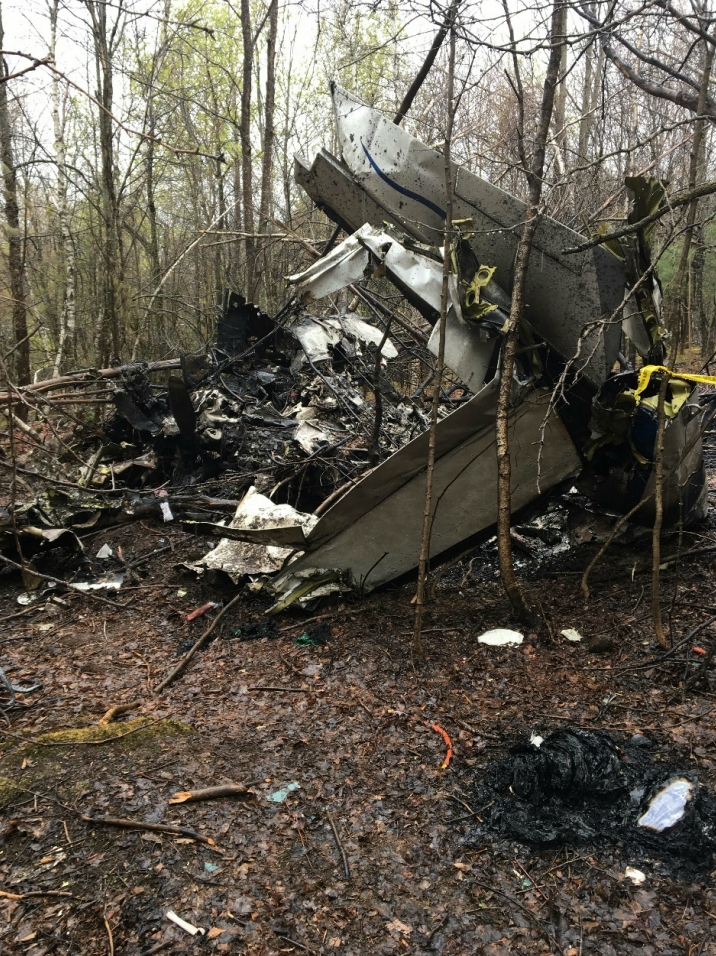
ASN Wikibase Occurrence # 195210
This information is added by users of ASN. Neither ASN nor the Flight Safety Foundation are responsible for the completeness or correctness of this information.
If you feel this information is incomplete or incorrect, you can submit corrected information.
| Date: | Wednesday 3 May 2017 |
| Time: | 20:30 |
| Type: |  Piper PA-31-310 Navajo C |
| Owner/operator: | Strait Air (2000) Ltd |
| Registration: | C-GQAM |
| MSN: | 31-7912093 |
| Year of manufacture: | 1979 |
| Engine model: | Avco Lycoming TIO-540-A2C |
| Fatalities: | Fatalities: 1 / Occupants: 1 |
| Aircraft damage: | Destroyed |
| Category: | Accident |
| Location: | E of Colton, St. Lawrence County, NY -
 United States of America United States of America
|
| Phase: | En route |
| Nature: | Cargo |
| Departure airport: | Québec City Jean Lesage International Airport, QC (YQB/CYQB) |
| St Hubert RCAF Station, QC (YHU/CYHU) | |
| Investigating agency: | NTSB |
| Confidence Rating: |
The commercial pilot departed on a planned 1-hour cargo cross-country flight in the autopilot-equipped airplane. About 3 minutes after departure, the controller instructed the pilot to fly direct to the destination airport at 2,000 ft mean sea level (msl). The pilot acknowledged the clearance, and there were no further radio transmissions from the airplane. The airplane continued flying past the destination airport in straight-and-level flight at 2,100 ft msl, consistent with the airplane operating under autopilot control, until it was about 100 miles beyond the destination airport.
A witness near the accident site watched the airplane fly over at a low altitude, heard three "pops" come from the airplane, and then saw it bank to the left and begin to descend. The airplane continued in the descending left turn until he lost sight of it as it dropped below the horizon.
The airplane impacted trees in about a 45° left bank and a level pitch attitude and came to rest in a heavily wooded area. The airplane sustained extensive thermal damage from a postcrash fire; however, examination of the remaining portions of the airframe, flight controls, engines, and engine accessories revealed no evidence of preimpact failure or malfunction. The fuel selector valves were found on the outboard tanks, which was in accordance with the normal cruise procedures in the pilot's operating handbook. Calculations based on the airplane's flight records and the fuel consumption information in the engine manual indicated that, at departure, the outboard tanks of the airplane contained sufficient fuel for about 1 hour 10 minutes of flight. The airplane had been flying for about 1 hour 15 minutes when the accident occurred. Therefore, it is likely that the fuel in the outboard tanks was exhausted; without pilot action to switch fuel tanks, the engines lost power as a result of fuel starvation, and the airplane descended and impacted trees and terrain.
The overflight of the intended destination and the subsequent loss of engine power due to fuel starvation are indicative of pilot incapacitation. The pilot's autopsy identified no significant natural disease: however, the examination was limited by the severity of damage to the body. Further, there are a number of conditions, including cardiac arrhythmias, seizures, or other causes of loss of consciousness, that could incapacitate a pilot and leave no evidence at autopsy.
The pilot's toxicology results indicated that the pilot had used marijuana/tetrahydrocannabinol (THC) at some point before the accident. THC can impair judgment, but it does not cause incapacitation; therefore, the circumstances of this accident are not consistent with impairment from THC, and, the pilot's THC use likely did not contribute to this accident. The reason for the pilot's incapacitation could not be determined.
Probable Cause: The pilot's incapacitation for unknown reasons, which resulted in an overflight of his destination, a subsequent loss of engine power due to fuel starvation, and collision with terrain.
Accident investigation:
 |
|
Sources:
NTSB
Location
Images:

Photo: NTSB
Media:
Revision history:
| Date/time | Contributor | Updates |
|---|---|---|
| 04-May-2017 05:14 | Geno | Added |
| 04-May-2017 15:07 | Geno | Updated [Aircraft type, Registration, Cn, Operator, Source, Damage, Narrative] |
| 04-May-2017 16:52 | Aerossurance | Updated [Location, Embed code] |
| 04-May-2017 19:09 | olinadeau | Updated [Phase, Departure airport, Destination airport, Source, Embed code] |
| 05-May-2017 09:23 | Anon. | Updated [Narrative] |
| 06-May-2017 09:04 | Iceman 29 | Updated [Source, Embed code] |
| 10-May-2017 07:25 | harro | Updated [Narrative] |
| 18-May-2017 08:08 | Local | Updated [Source, Narrative] |
| 07-Sep-2017 16:56 | Dr. John Smith | Updated [Narrative] |
| 07-Sep-2017 18:45 | Dr. John Smith | Updated [Nature, Departure airport, Destination airport, Source, Narrative] |
| 23-Oct-2017 21:10 | Dr. John Smith | Updated [Time, Location, Source, Narrative] |
| 23-Oct-2017 21:14 | Dr. John Smith | Updated [Narrative] |
| 11-Nov-2018 11:20 | ASN Update Bot | Updated [Time, Departure airport, Destination airport, Source, Embed code, Narrative, Accident report, ] |
| 11-Nov-2018 12:31 | harro | Updated [Embed code, Narrative, Photo] |
| 23-Feb-2020 22:32 | Captain Adam | Updated [Location, Departure airport, Destination airport] |
Corrections or additions? ... Edit this accident description
The Aviation Safety Network is an exclusive service provided by:


 ©2024 Flight Safety Foundation
©2024 Flight Safety Foundation